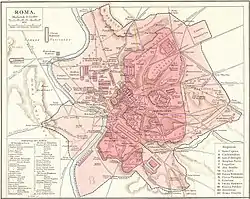Athenaeum (ancient Rome)
The Athenaeum was a school (ludus) founded by the Emperor Hadrian in Rome, for the promotion of literary and scientific studies (ingenuarum artium) and called Athenaeum from the city of Athens, which was still regarded as the seat of intellectual refinement.[1] The Athenaeum was situated near the Capitoline Hill: its site was discovered in 2009 during excavation for the construction of the Rome Metro C Line, in the middle of what is now Piazza Venezia.[2][3]
| Athenaeum of Hadrian (Rome) | |
|---|---|
 Excavations of the Athenaeum: View of the corridor between the central and the south hall | |
| Location | Regione VII Via Lata |
| Built by/for | Hadrian |
| Type of structure | Auditorium; Ludus |
  Athenaeum of Hadriam | |
A staff of professors, for the various branches of study, was regularly engaged. Under Theodosius II, for example, there were three orators, ten grammarians, five sophists, one philosopher, two lawyers, or jurisconsults. Besides the instruction given by these magistri, poets, orators, and critics were accustomed to recite their compositions there, and these prelections were sometimes honoured with the presence of the emperors themselves. There were other places where such recitations were made, as the Library of Trajan; sometimes also a room was hired, and made into an auditorium.
The Athenaeum seems to have continued in high repute till the sixth century. Little is known of the details of study or discipline in the Athenaeum, but in the constitution of the year 370, there are some regulations respecting students in Rome, from which it would appear that it must have been a very extensive and important institution. And this is confirmed by other statements contained in some of the Fathers and other ancient authors, from which we learn that young men from all parts, after finishing their usual school and college studies in their own town or province, used to resort to Rome as a sort of higher university, for the purpose of completing their education.
After the moving of the capital city to Milan and Constantinople similar schools were opened also in these cities, as well as in the other main cities of the Empire, like Carthage.
In the modern period, the term "Athenaeum" is widely used in various countries for schools, libraries, museums, cultural centers, performance halls and theaters, periodicals, clubs and societies - all aspiring to fulfill a cultural function similar to that of the ancient Roman school.
References
- Sherk (14 July 1988). The Roman Empire: Augustus to Hadrian. Cambridge University Press. pp. 181–. ISBN 978-0-521-33887-5.
- Carlo Alberto Bucci. "Roma, riaffiora l'ateneo di Adriano Ritrovata la scuola dei filosofi. La sala rettangolare è venuto alla luce durante gli scavi per il metrò I lavori non si fermano, spostata di pochi metri l'uscita della linea C." La Repubblica 9 October 2009
- Antonio López García (2015). Los Auditoria de Adriano y el Athenaeum de Roma. Firenze University Press. ISBN 978-88-6655-934-4.
![]() This article incorporates text from a publication now in the public domain: Smith, William, ed. (1870). Dictionary of Greek and Roman Antiquities. London: John Murray. Missing or empty
This article incorporates text from a publication now in the public domain: Smith, William, ed. (1870). Dictionary of Greek and Roman Antiquities. London: John Murray. Missing or empty |title= (help)